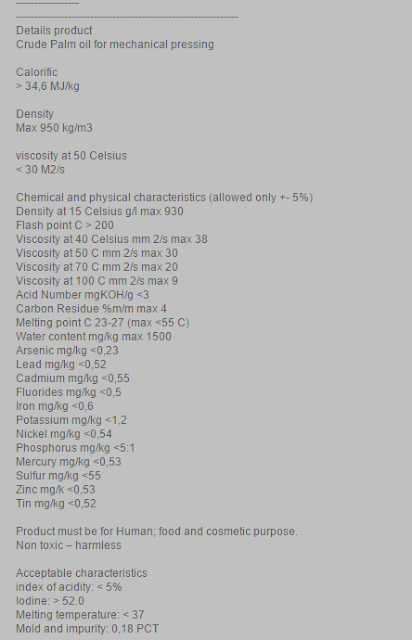 |
| Oil palms plantation |
One of the World Largest Palm Oil Exporter
The Oil Palm tree (Elaeis guineensis jacq.) originates from West Africa where it grows in the wild and later was developed into an agricultural crop. It was introduced to Malaysia, then Malaya, by the British in early 1870's as an ornamental plant.
In 1917, the first commercial planting took place in Tennamaran Estate in Selangor, laying the foundations for the vast oil palm plantations and the Palm oil industry in Malaysia. The cultivation of oil palm increased at a fast pace in early 1960s under the government's agricultural diversification programme, which was introduced to reduce the country's economic dependence on rubber and tin.
Later in the 1960s, the government introduced land settlement schemes for planting oil palm as a means to eradicate poverty for the landless farmers and smallholders. The oil palm plantations in Malaysia are largely based on the estate management system and smallholder scheme.
Read this Article : About Palm Oil
"Malaysia is one the largest producers and exporters of palm oil in the world, accounting for 11% of the world's oils & fats production and 27% of export trade of oils & fats."
Today, 4.49 million hectares of land in Malaysia is under oil palm cultivation; producing 17.73 million tonnes of palm oil and 2.13 tonnes of palm kernel oil. Malaysia is one of the largest producers and exporters of palm oil in the world, accounting for 11% of the world's oils & fats production and 27% of export trade of oils & fats. The industry provides employment to more than half a million people and livelihood to an estimated one million people.
Malaysia currently accounts for 39 % of world palm oil production and 44% of world exports. Being one of the biggest producers and exporters of palm oil and palm oil products, Malaysia has an important role to play in fulfilling the growing global need for oils and fats sustainably.
 |
| Oil Palm fruitlets |
Oil Palm Composition
Oil palm is a monoecious crop as it bears both male and female flowers on the same tree. Each tree produces compact bunches weighing between 10 and 25 kilograms with 1000 to 3000 fruitlets per bunch. Each fruitlet is almost spherical or elongated in shape. Generally, the fruitlet is dark purple, almost black and the colour turns to orange red when ripe. Each fruitlet consists of a hard kernel (seed) enclosed in a shell (endocarp) which is surrounded by a fleshy mesocarp.
Read this article : The Oil Palm and its Fruit
Palm trees may grow up to sixty feet and more in height. The trunks of young and mature trees are wrapped in fronds which give them a rather rough appearance. The older trees have smoother trunks apart from the scars left by the fronds which have withered and fallen off.
Oil palm tree will start bearing fruits after 30 months of field planting and will continue to be productive for the next 20 to 30 years; thus ensuring a consistent supply of oils. Each ripe bunch is commonly known as Fresh Fruit Bunch (FFB). In Malaysia, the oil palm trees planted are mainly the tenera variety, a hybrid between the dura and pisifera.
 |
| Fresh Fruit bunchs |
The tenera variety yields about 4 to 5 tonnes of Crude Palm Oil (CPO) per hectare per year and about 1 tonne of palm kernels. The oil palm is the most efficient oil-bearing crop in the world, requiring only 0.26 hectares of land to produce one tonne of oil while soybean, sunflower and rapeseed require 2.22, 2 and 1.52 hectares, respectively, to produce the same.
The refining of crude palm oil commenced in the early 70s in response to Government's call for increased industrialization. The emergence of refineries marked the introduction of a wide range of processed palm oil products.
In the 80s, another important milestone was marked where oleochemicals industry begins to flourish due to ample supply of palm and palm kernel oil. This also leads Malaysia to become a world leader in the oleochemicals sector to date.
 |
| Product Details |
Processing of Palm Oil
A unique feature of the oil palm is that it produces two types of oil - palm oil from the flesh of the fruit, and palm kernel oil from the seed or kernel. For every 10 tonnes of palm oil, about 1 tonne of palm kemel oil is also obtained. Several processing operations are used to produce the finished palm oil that meets the users' requirements. The first step in processing is at the mill, where the crude palm oil is extracted from the fruit. The various steps in extraction are shown in the Flow Chart.
Read this article : Palm Kernel and Palm Kernel Oil
A unique feature of the oil palm is that it produces two types of oil - palm oil from the flesh of the fruit, and palm kernel oil from the seed or kernel.
The crude palm oil may be further refined (second stage of processing) to get a wide range of palm products of specified quality. The partly and wholly processed grades require little further treatment before use, offering end-user a saving in processing costs.
Palm oil may also be fractionated, using simple crystallization and separation processes to obtain solid (stearin) and liquid (olein) fractions of various melting characteristics. The different properties of the fractions make them suitable for a variety of food and non-food products.
You may also like this Articles :
Chemical Composition of Palm Oil
Palm Oil Production and The Nutrition for Health
Social and Environmental Impact of Palm Oil
No comments:
Post a Comment